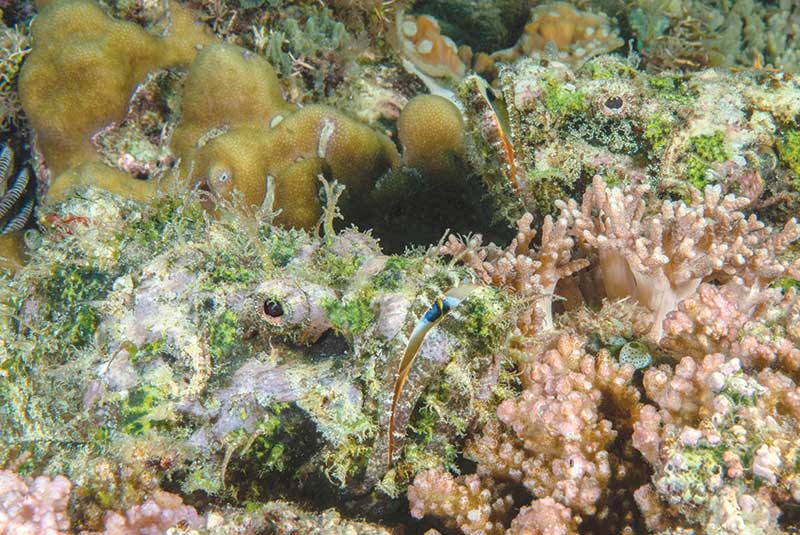The longer you look, the more you’ll see

By Michel Gilbert & Danielle Alary
Our eyes are sometimes slow to reveal the world around us. We can’t always trust them to show us what’s staring us in the face.
We depart for a dive on one of the many reefs surrounding the Puerto Galera peninsula on the island of Mindoro in the Philippines. Descending to a depth of around 50 feet (15m) we begin our exploration in search of specific subjects. As usual, Danielle wanders around the coral heads and I am stuck somewhere next to an inspiring sea creature; moving only my eyes and my index finger as I capture images.
At one of her few stops, Danielle spots a scorpionfish doing what a scorpionfish does, i.e., nothing but wait for an unassuming victim to swim by and eventually disappear in a big gulp.
She settles on the sandy bottom, adjusts the strobe position, dials-in the proper speed, aperture, and flash power. As she glues her mask to the optical viewfinder, her 180º view shrinks into the 44º of the 35mm lens mounted on a Nikon D300 APS-C camera.
She is now eye-to-eye with the scorpionfish. As if hypnotized, she is infatuated with her subject as it seduces her with the dominant greens of its camouflage. Tucked between coral formations, it looks at her without blinking the black eye that faces the camera housing.
She pulls the shutter release once. Checking the LCD screen, she sees a slightly overexposed image. A half-stop adjustment should suffice. The second lighting test comes out perfect. Danielle can now focus her attention on composition.
She wants her subject to appear at the bottom half, to the left of the image. The rule of thirds lines in her viewfinder help in composing the picture.
I think we have mentioned before that I am the photo techie in the family. Danielle knows her stuff, but she does not agonize over technical things in photography. She knows what she wants and how to get it and this is it!
Even if you buy her tons of drinks, she will never delve into dynamic range or the merits of a specific strobe brand power vs another. For her, it’s all about the image she makes in her mind. Photography is akin to driving a car. She does not concern herself with the innerworkings of the internal combustion engine; she wants to go from point A to point B and she can drive the vehicle; that’s enough.
As she concentrates on her photograph, her mind becomes even more focused (no pun intended) on the scorpionfish. She takes a couple of pictures and then waits until it slightly opens its mouth, revealing a blue spot on the inner side of the upper jaw.
Moving a little she tries a different angle, looks at the coral formation upon which the lower jaw pushes. There is a bit of beige, green and pink just like the fish’s overall camouflage.
Waiting in the relative silence of her bubbles, she secretly hopes that some innocent victim will show up and fall prey to the ugly stalker.
What a surprise
Despite her laser-focused attention, Danielle eventually decides to explore what she sees in the viewfinder besides her subject. Moving her eye to the upper left of the image she scans to the right and almost has a heart attack.
During all the time she spent worrying about her friend in the foreground, she never realized that there was another image within the image she was making.
As if there was an invisible mirror, another scorpionfish lies in the background. Identical to the first one, it had been, up to this point, outside the depth of field rendered by the fully open diaphragm (f/2) through which she was looking while pulling the shutter release.
In the resulting image on the LCD screen both fish appear in focus, thanks to the much smaller aperture necessary (f/18) for proper exposure. Danielle makes more photographs before leaving her spot, swearing at herself for not seeing the second scorpionfish at the outset.
What’s the lesson here?
During a good part of her dive, Danielle was unaware of the presence of a second scorpionfish. This is most revealing about her ability to concentrate her attention in order to achieve a goal. It also tells us that, in nature, it pays off to explore and take a fresh look at a potential subject and its surroundings.
Reviewing the images on the computer back in our room we found many images made well before Danielle noticed the twin in the background. They all sported the ‘invisible’ twin.
In the end, it made for a good lesson and a most satisfying dive.







